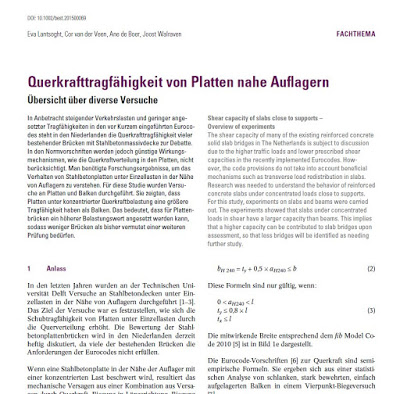Querkrafttragfähigkeit von Platten nahe Auflagern – Übersicht über diverse Versuche
My colleagues and I recently published a paper in Beton- und Stahlbetonbau. Writing in German was quite a challenge for me, so I’m quite proud of the final result. I spent many a morning muttering Ausbeimitnachseitvonzu in front of my screen, and browsing Google Translate. Because my German has its limits (heavy limits), we used the help of the translation services of Delft University of Technology to proofread the manuscript and clean up my grammar before submission (a decision that turned out to be very helpful).
You can access the paper here.
The German abstract of the paper is as follows:
In Anbetracht steigender Verkehrslasten und geringer angesetzter Tragfähigkeiten in den vor Kurzem eingeführten Eurocodes steht in den Niederlanden die Querkrafttragfähigkeit vieler bestehender Brücken mit Stahlbetonmassivdecke zur Debatte. In den Normvorschriften werden jedoch günstige Wirkungsmechanismen, wie die Querkraftverteilung in den Platten, nicht berücksichtigt. Man benötigte Forschungsergebnisse, um das Verhalten von Stahlbetonplatten unter Einzellasten in der Nähe von Auflagern zu verstehen. Für diese Studie wurden Versuche an Platten und Balken durchgeführt. Sie zeigten, dass Platten unter konzentrierter Querkraftbelastung eine größere Tragfähigkeit haben als Balken. Das bedeutet, dass für Plattenbrücken ein höherer Belastungswert angesetzt werden kann, sodass weniger Brücken als bisher vermutet einer weiteren Prüfung bedürfen.
The English abstract of the paper is as follows:
The shear capacity of many of the existing reinforced concrete solid slab bridges in The Netherlands is subject to discussion due to the higher traffic loads and lower prescribed shear capacities in the recently implemented Eurocodes. However, the code provisions do not take into account beneficial mechanisms such as transverse load redistribution in slabs. Research was needed to understand the behavior of reinforced concrete slabs under concentrated loads close to supports. For this study, experiments on slabs and beams were carried out. The experiments showed that slabs under concentrated loads in shear have a larger capacity than beams. This implies that a higher capacity can be contributed to slab bridges upon assessment, so that less bridges will be identified as needing further study.


May I ask why you chose to publish in German if none of you speaks German? Is it really helpful to have a publication in a language one doesn't speak besides the English version of the same paper? Thanks!
We wanted to publish in German because the amount of experimental research that is done in Germany is so large that it can stand on its own, if that makes snese to you?